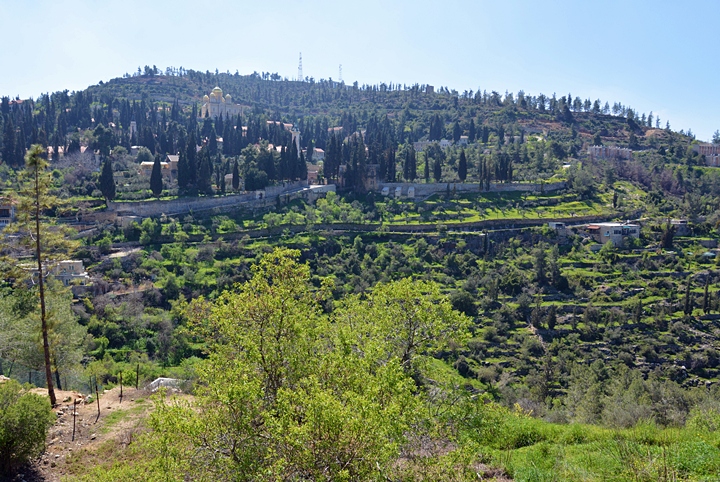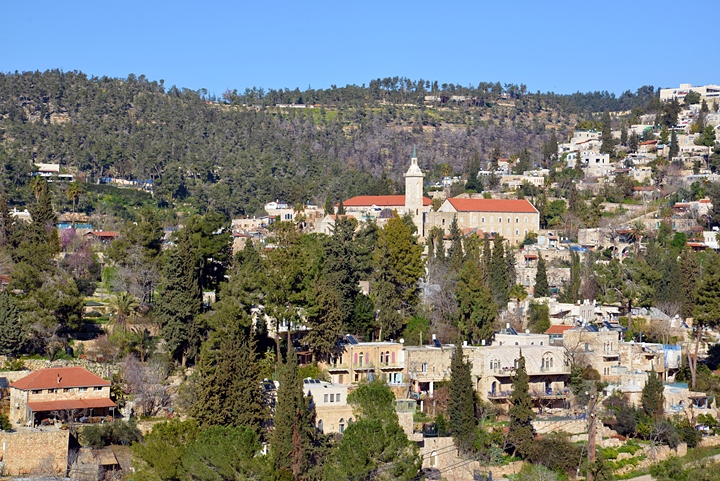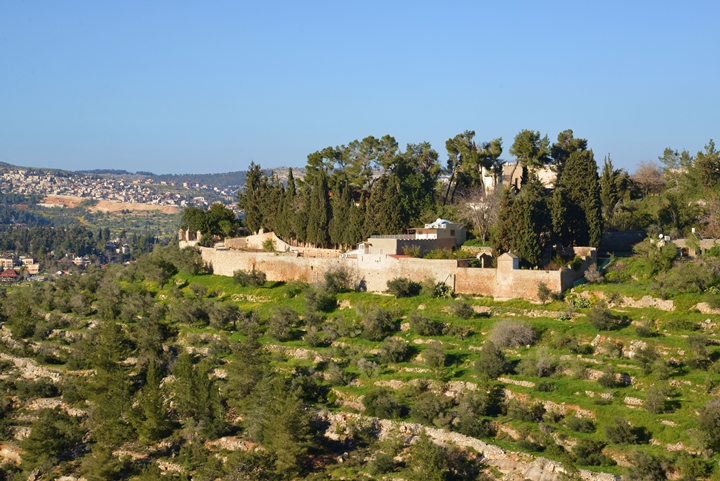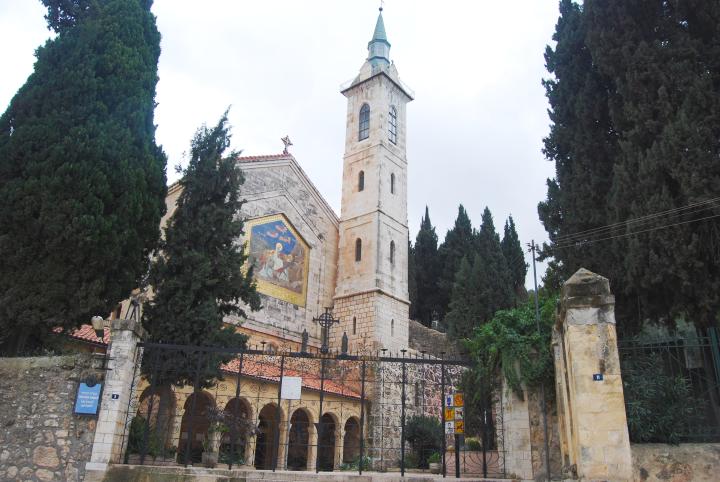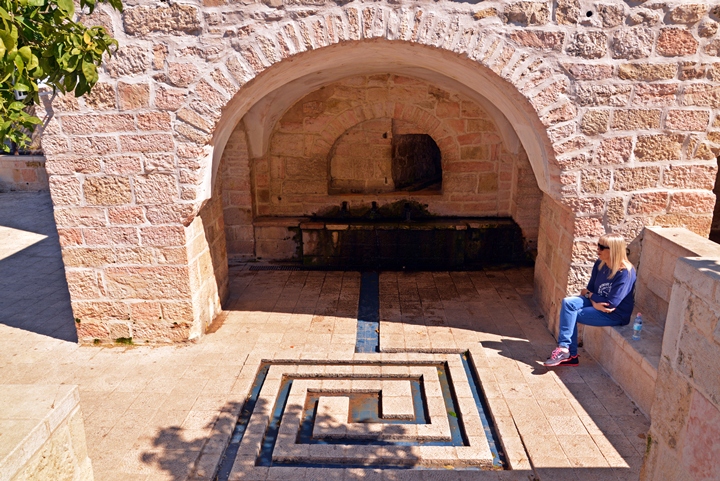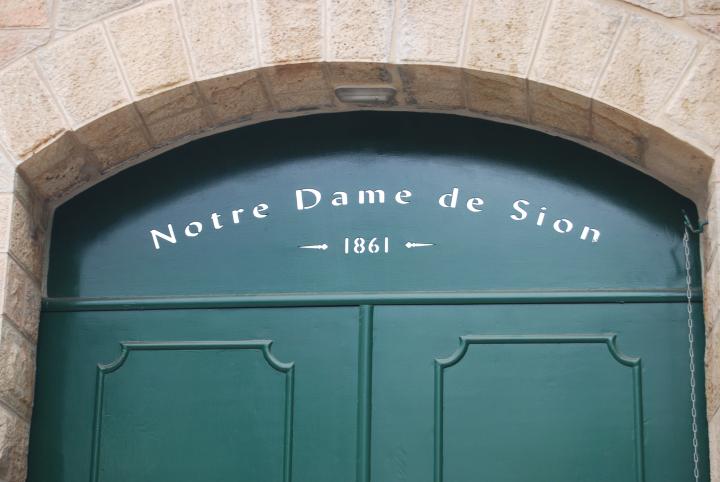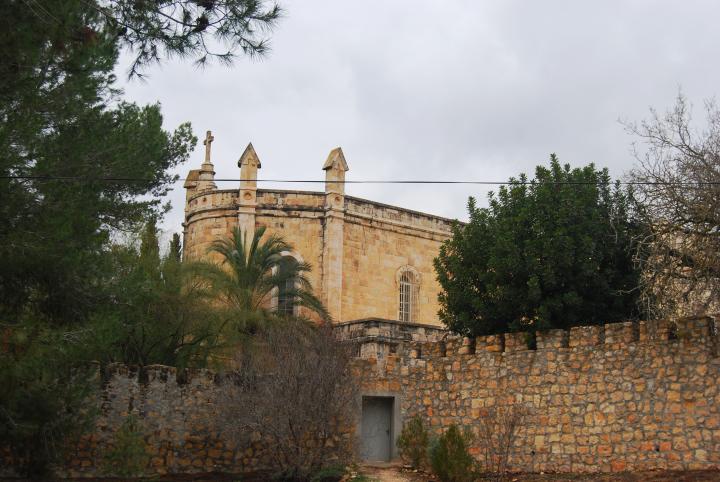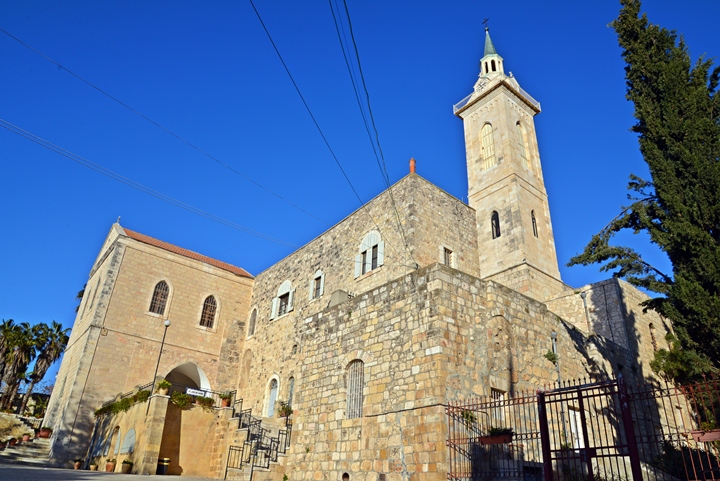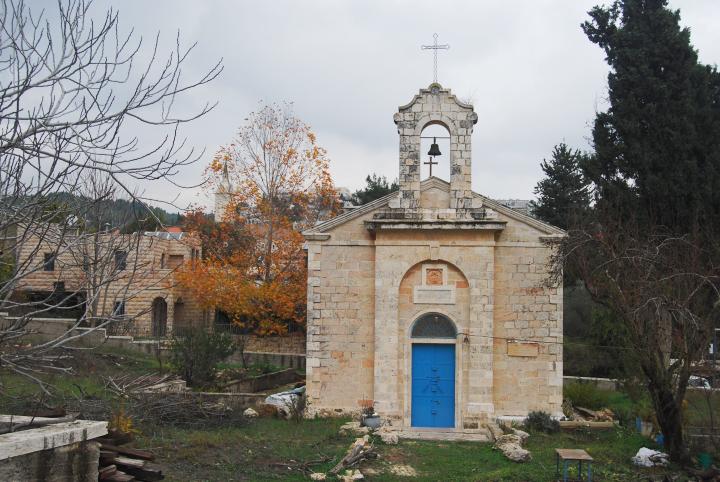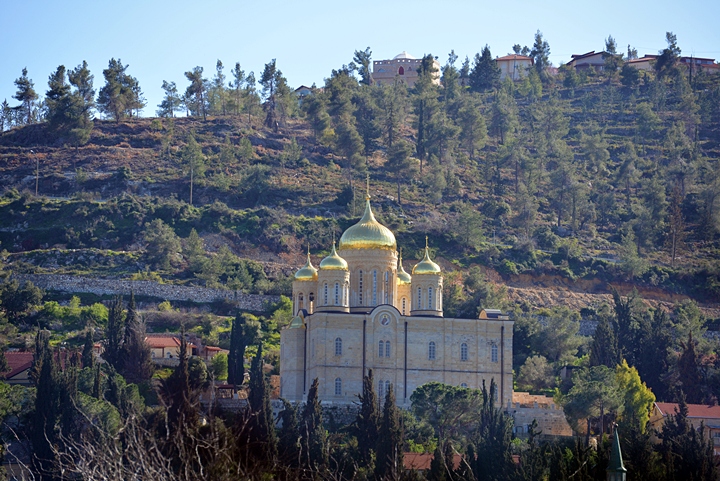The village of Ein Kerem, on the west side of Jerusalem, is according to tradition the birthplace of John the Baptist.
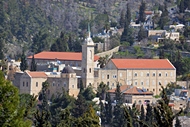
Home > Sites > Jerusalem > Ein Kerem (Karem) – Overview
Contents:
Overview
Location
History
Photos
* General view
* Visitation
* Mary’s spring
* N Dame deSion
* St John
* Greek Orthodox
* Russian church
Biblical Refs
Etymology
Links
Overview:
The village of Ein Kerem (Ein Karem), on the west side of Jerusalem, is according to tradition the birthplace of John the Baptist. Five churches and monasteries are located around the village: St. John (birthplace of John), Visitation church (named after virgin Mary’s visited to the summer house of John), Russian monastery (Al Moskovia), Greek Orthodox convent of St. John, and the monastery of Notre Dame De Sion.
In earlier periods, the village was a Canaanite site which evolved around the spring that gave its name (Ein Kerem – “the spring of the vineyard”). The site is identified as “Beit Hakerem” from the Israelite period (Jeremiah 6,1): “O ye children of Benjamin, gather yourselves to flee out of the midst of Jerusalem, and blow the trumpet in Tekoa, and set up a sign of fire in Bethhaccerem”.
Location:
The Holy sites are located in the village of Ein Kerem (Ein Karem), west of Jerusalem (8KM from the center), on the road numbered #386.
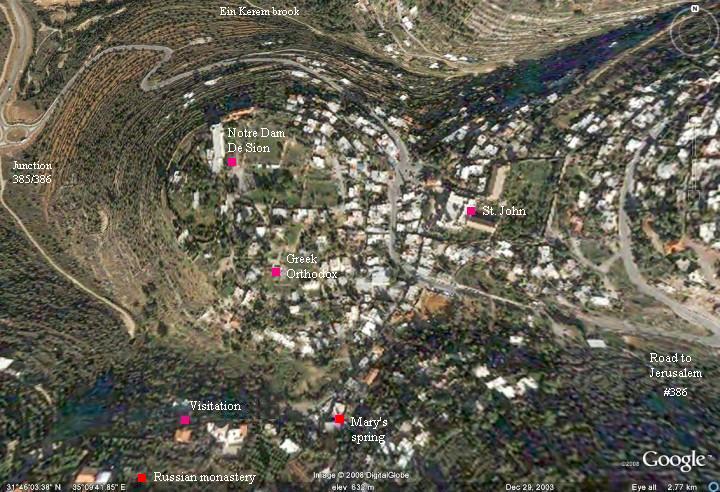
History:
- Biblical periods
The Bronze/Iron age Canaanite site was built around the spring in the valley of Ein Kerem (called ” Mary’s spring”).
During the Israelite period, Ein Kerem was within the region of the tribe of Judah. It may have been called Beth-Hakerem, or “house of the vineyard”: the Bible implies that it is close to Jerusalem, since a fire sign was used on the top of the Kerem hill to signal the approach of an enemy: (Jeremiah 6,1):
“O ye children of Benjamin, gather yourselves to flee out of the midst of Jerusalem, and blow the trumpet in Tekoa, and set up a sign of fire in Bethhaccerem: for evil appeareth out of the north, and great destruction”.
- Persian/Hellenistic period
Beth Hakerem was a regional center, which administrated the villages around it during the Persian conquest (5th century BC). Nehemiah 3 14: “But the dung gate repaired Malchiah the son of Rechab, the ruler of part of Bethhaccerem; he built it, and set up the doors thereof, the locks thereof, and the bars thereof”.
The water channel in Mary’s spring is dated to the second temple period. It was cut into the rock in order to increase the spring’s capacity.
- Roman period
According to Christian tradition, the village was a summer house for Zacharias and Elizabeth, parents of John the Baptist. The village was called “city of Juda” in the description of the visit by Luke.
Elizabeth (Elisheva) was the cousin of Mary, mother of Jesus. As per Luke, Mary visited Elizabeth when both were pregnant (hence the name – Church of visitation). During the visit, the baby leapt with joy in Elizabeth’s womb and Elizabeth was filled with the Holy Spirit, knowing Mary that she is about to give birth to the son of God. Mary then stayed with her cousin for 3 months until John was born, and left to Bethlehem.
John is an important figure in Christianity , and regarded as the “forerunner” – since John Baptized Jesus, and proclaimed Jesus as the Messiah.
- Byzantine period
The village and the spring is Holy for Christians, and several churches and monasteries were built during the Byzantine period. The visitation Crusaders church, on its “upper” floor, was built over one of them. St John was also built over ruins of Byzantine period.
- Crusaders period
The Crusaders rebuilt some of the ruined Byzantine churches. The upper floor of the visitation church shows remains of the Crusaders church, especially on the south wing.
- Ottoman period
The Franciscan monks started to settled here in 1674. They purchased lands and houses. After the village expanded, more Christian orders established presence in the popular pilgrimage site. The churches and monasteries were reconstructed in the late Ottoman period and Modern times –
- St. John was built in the end of the 19th C and completed in 1920.
- The monastery of sisters of our Lady of Zion was built in 1860/1.
- The Greek-Orthodox church was built at the end of the 19th C, and was reconstructed in 1975.
- The visitation church was reconstructed in 1955.
- The Russian church started construction in 1871.
PEF Survey: The area of Ein Kerem (Ain Karim) was examined in the Palestine Exploration Foundation (PEF) survey (1866-1877) by Wilson, Conder and Kitchener. The map below is a section of their survey results. The sites of Ein Kerem are described in their report (Vol 3, Sheet XVII, pp 60-61):
” ‘Ain Karim – South of the modern village near the wall of the convent of the Sisters of Sion are three rock-cut tombs.
-
No. I, furthest east, contains two kokim at the back, and one each side of a square chamber.
-
No. 2 is choked.
-
No. 3 has a square ante-chamber, and an Inner chamber 1 1/2 feet lower,
-
with a bench round three sides and a koka at the back.
On the southern hill west of the spring (‘Ain Sitti Miriam), and close to the new Russian hospice, ruins were discovered by the Latins, in 1861, in building the new Chapel of the Summer-House of Zacharias.
The grounds were excavated to a depth of 15 to 20 feet, and the lower story of the old church (mentioned by John Poloner (1422) as having a subterranean and an upper chapel) was found.
All that can now be seen is the recent reconstruction, except a small cave, or vault, south of the altar, which is at the east end. A piece of stone is here shown which melted like wax, and hid John the Baptist, as an infant, from Herod’s soldiers. Outside this chapel on the south are arches and vaults in ruins, remains of a former monastery. The masonry is of good size and finish, some stones drafted. A courtyard is entered from the west, and a stone rib, with low point, rises from a massive pier ; these are remains of a vault of which the rag-work has disappeared.
There is diagonal dressing on the stones, but no masons’ marks occur. A narrow staircase leads up from the cloister north of the court to a chapel above that before noticed. Only the foundations of its walls remain ; the apse and part of a stone altar are traceable ; the interior was once covered with plaster and painted in fresco. There are many graffiti on the plaster, and on one stone a rude cutting representing the highpriest’s breastplate no doubt due to the tradition which erroneously supposes Zacharias to have been a high-priest. On the south side of the apse is the piscina. South of this chapel are remains of cells and steps, the rock being scarped. These ruins are partly hid by the soil of an orchard, which once covered the entire site, and in which the chapels and other buildings were found buried”.
Part of map sheet 17 of Survey of Western Palestine,
by Conder and Kitchener, 1872-1877.
(Published 1880, reprinted by LifeintheHolyLand.com)
Their report continues:
” ‘Ain Karim was given to the Franciscans through the influence of the Marquis de Nointal, Ambassador of Louis XIV. to the Sultan of Turkey. The church and monastery probably date back only to this time, as the absence of masons’ marks seems to indicate that the masonry is not of the twelfth century, nor does the finish of the work resemble that of Crusading buildings. There are two good springs within the limits of the property.
The Church of the Baptist, in the village itself, is of Crusading origin ; but the interior has been covered with encaustic tiles, and none of the older work is recognizable. The dome rises from four heavy piers ; the grotto north of the high altar (at the east end of the church), is reached by seven steps ; it is said to be the birthplace of St. John. A bad copy of a Murillo is hung on the north side of the church, and much prized by the monks, who are chiefly Spaniards.
Revisited 20th July, 1881″.
A north view of Ain Karim in 1943 is seen here, as viewed from the tower of St. John. In front, leading south, is a road to Mary’s spring. On the far right is the visitation church, and on the far center is the Russian monastery.

Photos of the Library of Congress – American Colony – part of Matson collection
- Modern times
The Arab village of Ain Karim was evacuated during the Independence war. After 1948 the village was rebuilt and new immigrants built the new Ein Kerem, which is part of the municipality of Jerusalem. Many artists and academics moved into the village.
Today, Ein Kerem is a remarkable and picturesque village, with old Arabic style houses and lovely gardens. Many pilgrims visit the holy sites of Ein Kerem while staying in the vicinity of Jerusalem, and the village attracts tourists and families who come to enjoy the special atmosphere, or stay at its guest houses.
Photos:
(a) General views:
The photo shows a view of the southern side of Ein Kerem. The “visitation” path, from Mary’s spring to the Visitation church , is seen in the middle of the view. On the hillside is the Visitation church (center) and the Moskubiya Russian church (top left).
Click on the photos to view in higher resolution…
The next view shows the northern side of the village, with St. John in the center, is seen here.
A view of the western side of the hill of Ein Kerem is in the next photo. In the center, on top of the hill, is the walled compound of the monastery of Sisters of Our Lady of Zion. The ancient terraces on the foothills were used for agriculture.
(b) Visitation church
The facade of the visitation church is seen below. This is a Franciscan church, built in 1955 and designed by the Italian famous church architect, Antonio Barluzzi, who also designed other churches such as the Mount of Beatitudes, Dominus Flevit and Basilica of Agony.
![]() For more information and photos on the Visitation church, click here.
For more information and photos on the Visitation church, click here.
(b) Mary’s spring:
The spring was the nucleus of the Canaanite city in the Bronze period, and its waters were used as the main source of water for thousands of years since then. Ein Kerem is actually named after the spring (Hebrew: Ein = spring, Kerem = vineyard).
A mosque, whose tower is seen below rising above the structure of the spring, was built over Mary’s spring in the 2nd half of the 19th C.
![]() For more information and photos on Mary’s spring, click here.
For more information and photos on Mary’s spring, click here.
(c) Notre Dame De Sion:
On the western side of the top of the hill is the monastery of Sisters of Our Lady of Zion (Notre Dame De Sion), built in 1860/1.
A view from the eastern side of the monastery. The place started as an orphanage and as the private house of its owner. It is operated by the order of nuns of the Zion sisters, and was converted to function as a guest house.
![]() For more information and photos on the convent, click here.
For more information and photos on the convent, click here.
(d) St. John Ba-Harim:
A view of the church of St. John is seen from the north-west. Its tall bell tower dominates the center of the village.
![]() For more information and photos on St. John – click here.
For more information and photos on St. John – click here.
(e) Greek Orthodox Convent:
On the south side of Ein Kerem hill, close to Notre Dame de Sion, is the St. John Greek Orthodox convent. This small structure was built at the end of the 19th C, and was reconstructed in 1975.
![]() For more information and photos on the Greek Orthodox church – click here.
For more information and photos on the Greek Orthodox church – click here.
(f) Russian church:
The Russian church, seen below, is located above the Visitation church, on the south side of Ein Kerem. The church is located inside the area of the Russian monastery called Moskkubia (Al Moskovoia). The 5-onion-dome structure started construction in 1905 and completed only in 2005, and later its domes were painted in gold. (Thanks for S. Browns for his corrections).
![]() For more information and photos on the Russian convent – click here.
For more information and photos on the Russian convent – click here.
Biblical:
Luke 1: 39-56:
The visit of Mary to the house of Zacharias, father of John the Baptist, in Ein Kerem (“city of Juda”).
“And Mary arose in those days, and went into the hill country with haste, into a city of Juda; And entered into the house of Zacharias, and saluted Elisabeth. And it came to pass, that, when Elisabeth heard the salutation of Mary, the babe leaped in her womb; and Elisabeth was filled with the Holy Ghost: And she spake out with a loud voice, and said, Blessed art thou among women, and blessed is the fruit of thy womb. And whence is this to me, that the mother of my Lord should come to me? For, lo, as soon as the voice of thy salutation sounded in mine ears, the babe leaped in my womb for joy. And blessed is she that believed: for there shall be a performance of those things which were told her from the Lord. And Mary said, My soul doth magnify the Lord, And my spirit hath rejoiced in God my Saviour. For he hath regarded the low estate of his handmaiden: for, behold, from henceforth all generations shall call me blessed. For he that is mighty hath done to me great things; and holy is his name. And his mercy is on them that fear him from generation to generation. He hath shewed strength with his arm; he hath scattered the proud in the imagination of their hearts. He hath put down the mighty from their seats, and exalted them of low degree. He hath filled the hungry with good things; and the rich he hath sent empty away. He hath holpen his servant Israel, in remembrance of his mercy; As he spake to our fathers, to Abraham, and to his seed for ever. And Mary abode with her about three months, and returned to her own house”.
Etymology (behind the name):
* Names of the site:
- Kerem – Hebrew: vineyard or olive-grove. As in 1 Kings 23 1: “”And it came to pass after these things, that Naboth the Jezreelite had a vineyard”.
- Ein, Ma’ayan – Hebrew: spring. Based on “Ma’im” – water. There are dozens of references in the Bible, since water was a major factor in this dry land.
- Ein Kerem (Karem) – the spring of the vineyard.
- Ain Karim – Arabic name of Ein Kerem, meaning “The spring of the dresser of the soil” (PEF Arabic and English name lists volume, 1881, p. 280
- BetHaccerem – Hebrew: The house of the vineyard. Beth – house.
* Other names:
- Zacharias (Zechariah) – Hebrew: God (Iah) will remember (Zachar) him. Zacharias was a priest, a relative of Jesus and John’s father. There are forms of the name – such as Zachariah son of Barachiah – the 6th C BC prophet – who is also referred in the new testament (Matthew 23 35).
- Domus Zachariae – Latin name of Ein Kerem – “The house of Zechariah”
- John – the Baptist. from Hebrew, “Yochanan”, which means: Yo (God) + Chanan (Pardoned). Thus the name in Hebrew means ” God has pardoned”. Biblical Reference: Mark 1 4,5: “John did baptize in the wilderness…in the river of Jordan”.
- Elizabeth – from Hebrew: “My God is my oath”; Eli – my God, Sheva – Hebrew for oath- Shvuah (also: seven).Mother of John the Baptist. There are other Elisheva in the Bible – a wife of Aaron (Exodus 6 23: “And Aaron took him Elisheba, daughter of Amminadab, sister of Naashon, to wife; and she bare him Nadab, and Abihu, Eleazar, and Ithamar”).
Links:
On Ein Karem:
* Jerusalem archaeological survey (pdf, Hebrew):
- ‘En Kerem, St. John
- ‘En Kerem, Church of Visitation
- ‘En Kerem, Mary’s spring
- Ancient agriculture
- Library of Congress – photos of Ain Karim
- 1st Century ritual bath found in Ein Kerem
* BibleWalks sites in Ein Kerem:
- Visitation church
- Mary’s spring
- St. John Ba Harim
- Greek Orthodox
- Sisters of Lady of Zion
- Russian Convent
On Religion:
BibleWalks.com – touring the Holy Land with the Bible
St. Andrew’s<<<—previous Jerusalem site–<<< All Sites >>>—>>> Visitation Church
![]()
This page was last updated on July 3 2015 (Added Mikveh discovery)
Sponsored links:
